Simpoh AirDillenia suffruticosa (Griff. ex Hook.f. & Thomson) Martelli.
Have you ever wondered what leaves were used to wrap your grandma’s tempeh or how people in the past wrap their food for takeaways?
Table of Contents
Yes! It is none other than the leaves of the Simpoh Air, Dillenia suffruticosa!
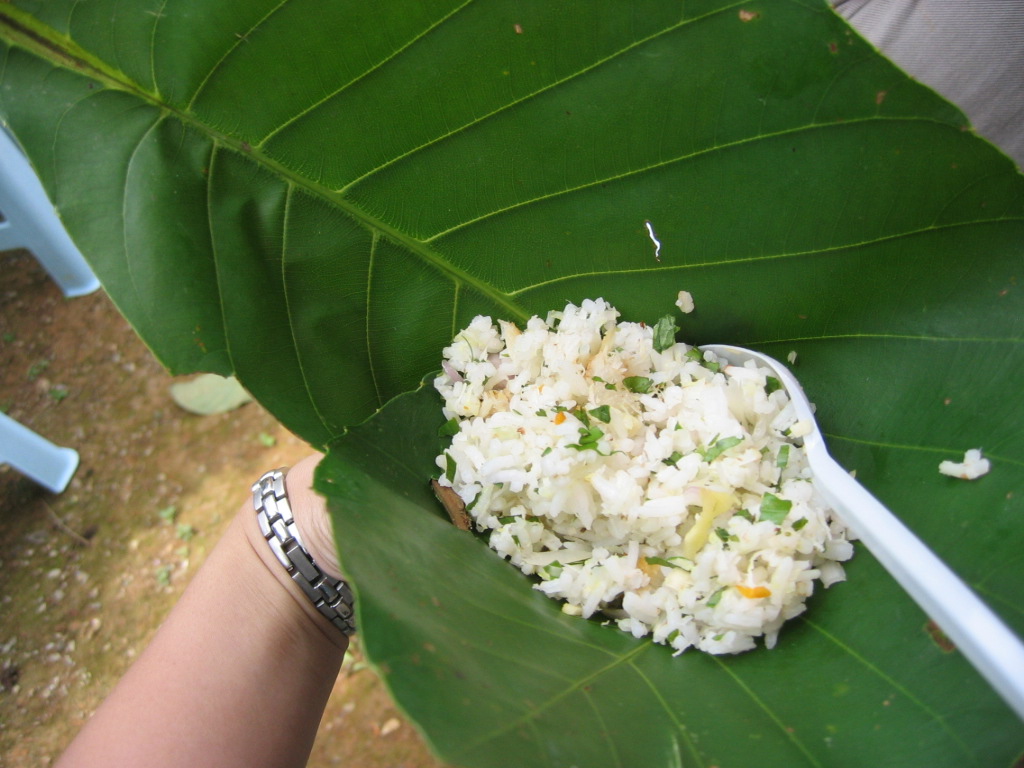 |
| Rice wrapped in leaves of Simpoh Air. Photo © November Tan (Permission pending). |
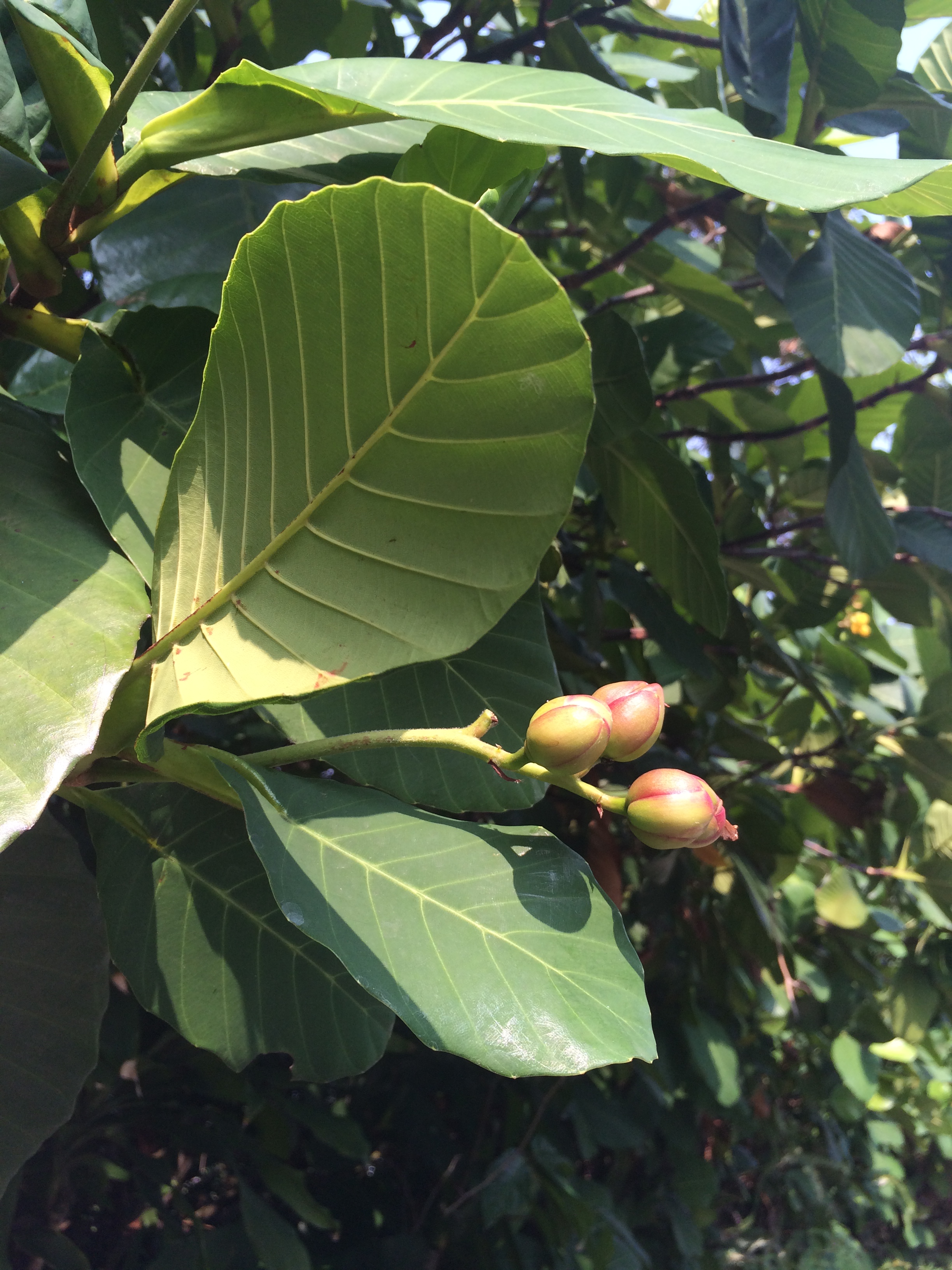 |
| Simpoh Air with unopened fruits. The broad leaves are used in the above photo to wrap food! Photo © Vanessa Lee. |
1. What is it?
1.1 General information
| Common names Simpoh Air, Simpuh Air, Simpoh Ayer, Simpoh, Shrubby Simpoh, White Simpoh, Yellow Simpoh. Scientific name Dillenia suffruticosa (Griff. ex Hook.f. & Thomson) Martelli (1887) Origin of name Dillenia: named after J. J. Dillenius [1684−1747], a German botanist and a professor at Oxford University; suffruticosa: Latin, shrubby. [12] Synonyms Dillenia burbidgei (Hook. f.) MartelliDillenia suffruticosa var. borneensis Ridl.Wormia burbidgei Hook. f.Wormia subsessilis Miq.Wormia subsessilis var. borneensis Ridl.Wormisa suffruticosa Griff. Status in Singapore: Common. [9] |
Scientific Classification [9] Kingdom: Plantae Phylum/Division: Magnoliophyta Class: Eudicots Order: Dilleniales Family: Dilleniaceae Genus: Dillenia Species: suffruticosa |
Did you know??
- The large leaves were once used to wrap food until plastic bags became popular! [9]
- ‘Air’ means ‘water’ in Malay; this naming could have come across to the locals because the presence of this plant often indicates a nearby underground water source. [14]
- This plant is an important pioneer species in the secondary succession of Southeast Asian coastal hill forest!
- It is a native plant to Singapore. [6]
- Its flowers do not have any fragrance or produce any nectar?
2. How does it live?
2.1 Biology
2.1.1 Habitat
Being one of the few species that appear in the secondary succession after exhaustive agricultural exploitation on land cleared of primary lowland rainforest [10], they can usually be found growing along forest edges, streams, and in marshes, secondary forests, and swampy grounds, up to 500 m altitude. [12] In Singapore, they can usually be found colonizing areas where lands are left empty. It is common to find them growing in large numbers along roadsides, often a wall of them. These are considered hardy plants, able to survive in disturbed lands where nutrients are poor and the soil is very compact. [14] This plant also prefers growing at places where it can receive full sunlight for growth.
| Simpoh Air at Kent Ridge Park, growing in areas with full sunlight. Photo © Vanessa Lee. |
2.1.2 Ecology
The plant provides food and shelter for other plants and creatures. It is a pioneer species because it is capable of germinating and growing on white sands, thus providing shade for less hardy plants to establish themselves. [14]
The flowers usually bloom in the early morning while it is still dark. [18] Pollination of the Simpoh Air flowers are done by carpenter bees (Xylocopa spp.) or beetles and flies that scramble over it. In particular, Xylocopa spp. is capable of buzz pollination, a technique used by some bees to release pollen which is held by the anthers, allowing pollination to be more efficient.
Carpenter bees feed on pollen by holding onto the tube that leads to the pollen with their jaws and vibrating hundreds of times per second. When the pollen is released, some gets stuck on them and as they fly off to the next flower, the extra pollen can fertilize another plant. (Video taken from YouTube by MelittologyNancy)
The ripe fruits open in the early morning when it is still dark, revealing seeds wrapped in red arils. [18] The seeds of this plant are often dispersed by birds, which find the tiny bit of red flesh (arils) surrounding the seeds irresistible. [12]
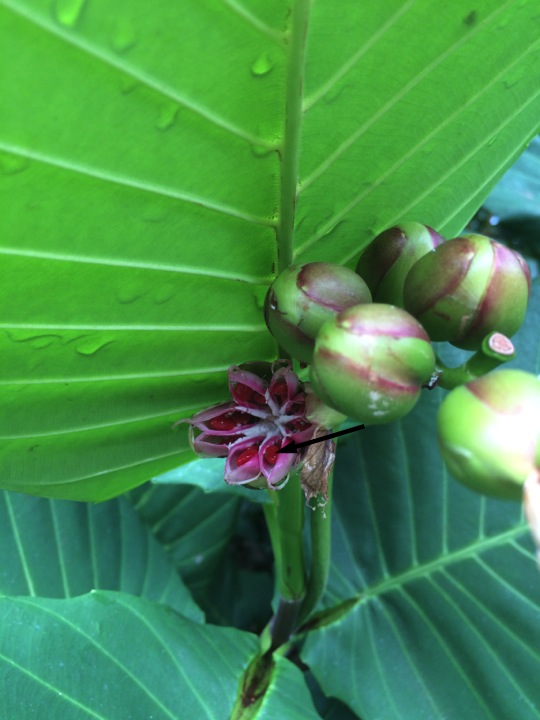 |
| Pink aril showed by a black arrow is often eaten by birds which then helped the plant in seed dispersal. The "buds" to the right of the fruit are actually developing fruits, which are often mistaken for flower buds. Photo © Vanessa Lee. |
3. Where can I find them?
3.1 Distribution
3.1.1 Natural Range
Can be found throughout Southeast Asia. [6]
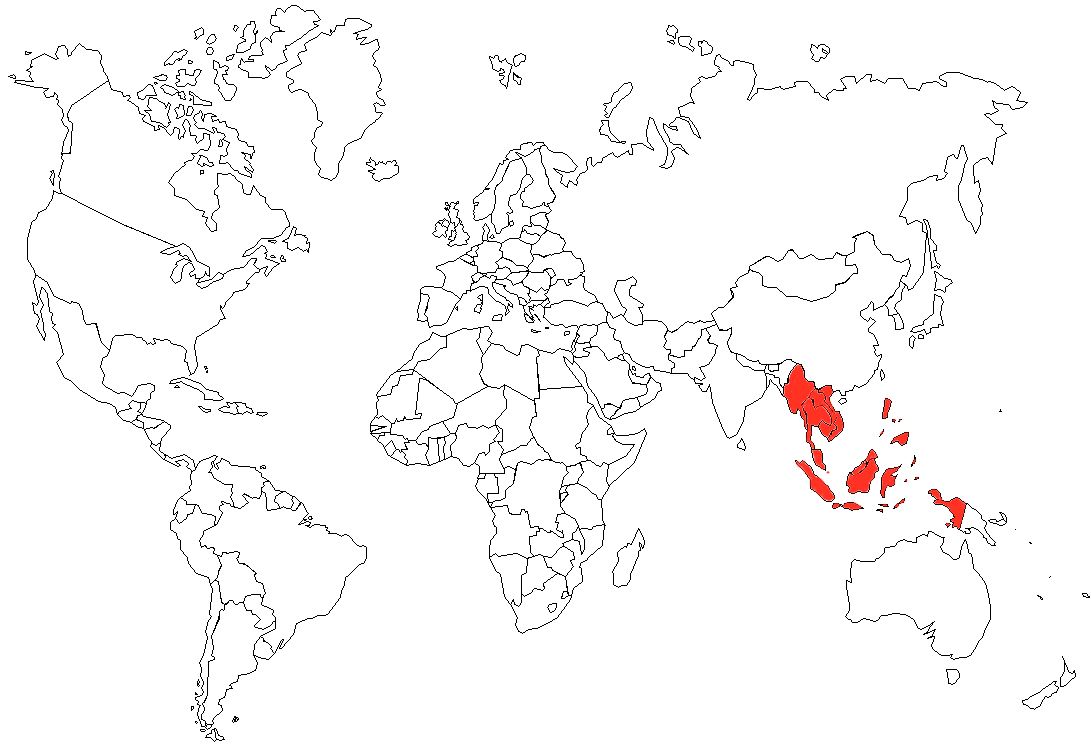 |
| Distribution of Simpoh Air in the world marked in read. The lands marked in red consist of the Southeast Asia countries. Map © Ray Brownrigg (Ray.Brownrigg@ecs.vuw.ac.nz). Map edited by Vanessa Lee. |
3.1.2 In Singapore
Occurs from coastal forest to inland forest, usually found in wetter areas. [18]
4. How can I identify them?
4.1 Descriptions
4.1.1 Structure
Large shrub, able to grow up to 6 m tall! [12]
4.1.2 Leaves
The spiraling arranged leaves have a leaf stalk which forms a sheath.
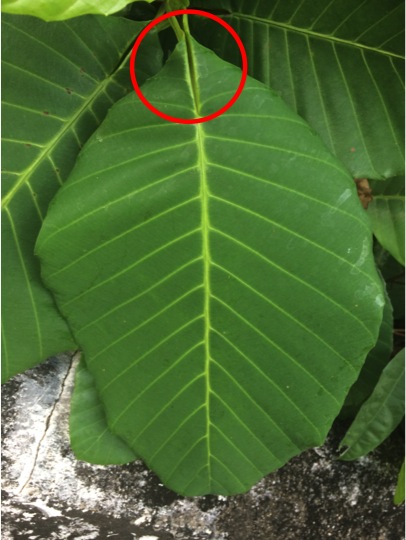 |
| Sheath on a typical leaf of Simpoh Air circled in red. This plant has its nickname "CB plant", with "CB" being the initials for the Hokkien name for the female genitalia. Photo © Vanessa Lee. |
| Alternating patterns of leaf branching out with the stem. Photo © Vanessa Lee. |
The large leaf blades (about 35 cm long) have prominent secondary veins which are parallel to each other. [12] [14] The leaves are leathery, green and oval, with slightly toothed edge. [6] [14]
| Look how big the leaf of Simpoh Air is as compared to the 15-cm ruler! Photo © Vanessa Lee. |
4.1.3 Flowers
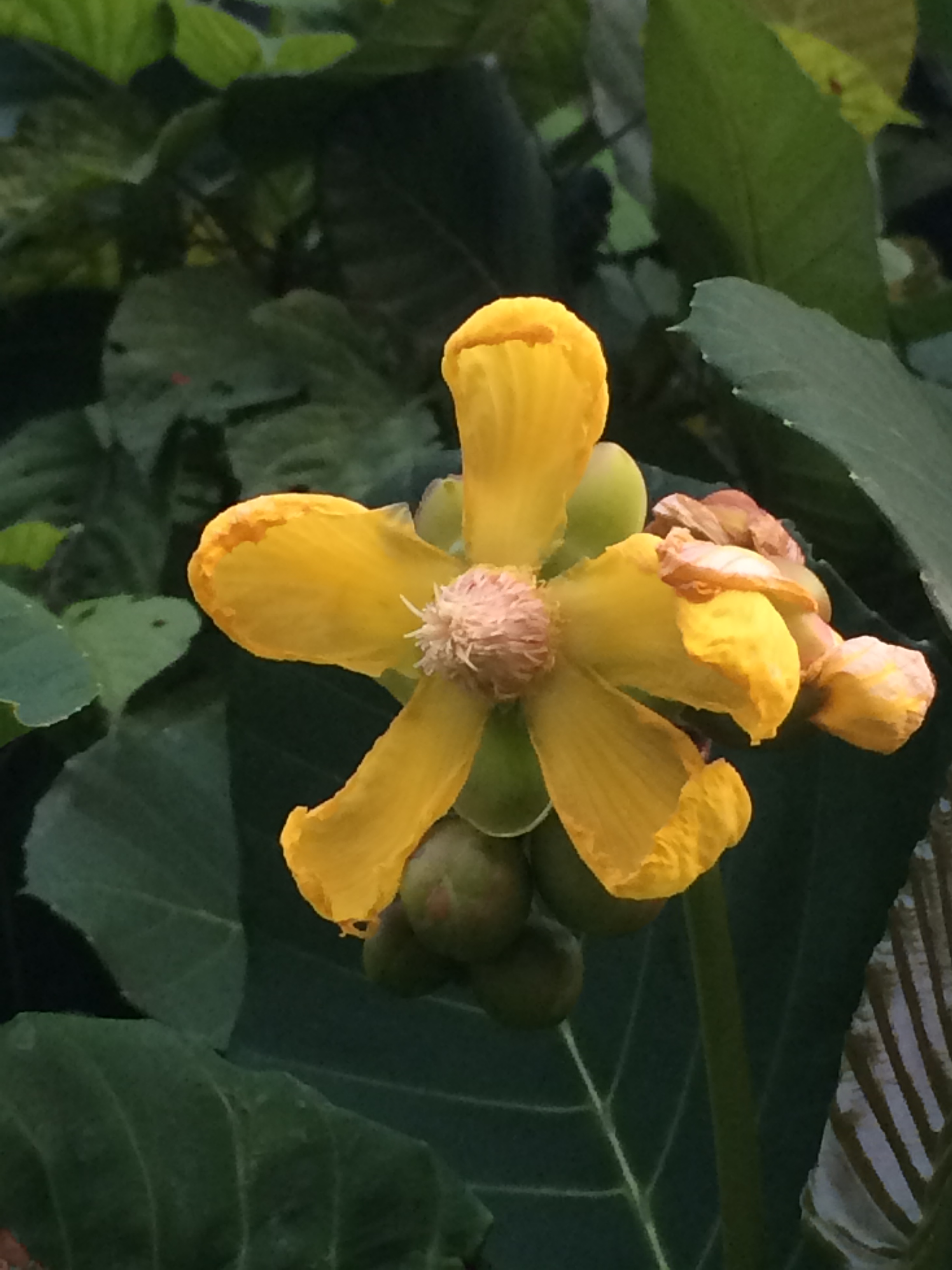 |
| A yellow Simpoh Air flower. Photo © Vanessa Lee. |
Large flowers of 10-12.5 cm across have yellow petals, usually consisting of 5 petals! [12] [14] The flowers are usually clustered. Blooming in the early morning when the sky is still dark (at about 3 am), they only last for a day. [14] [18] To avoid self-pollination, at any point of time only a single flower from a cluster is opened to avoid pollination to happen within the same cluster of flowers.
4.1.4 Fruit & Seed
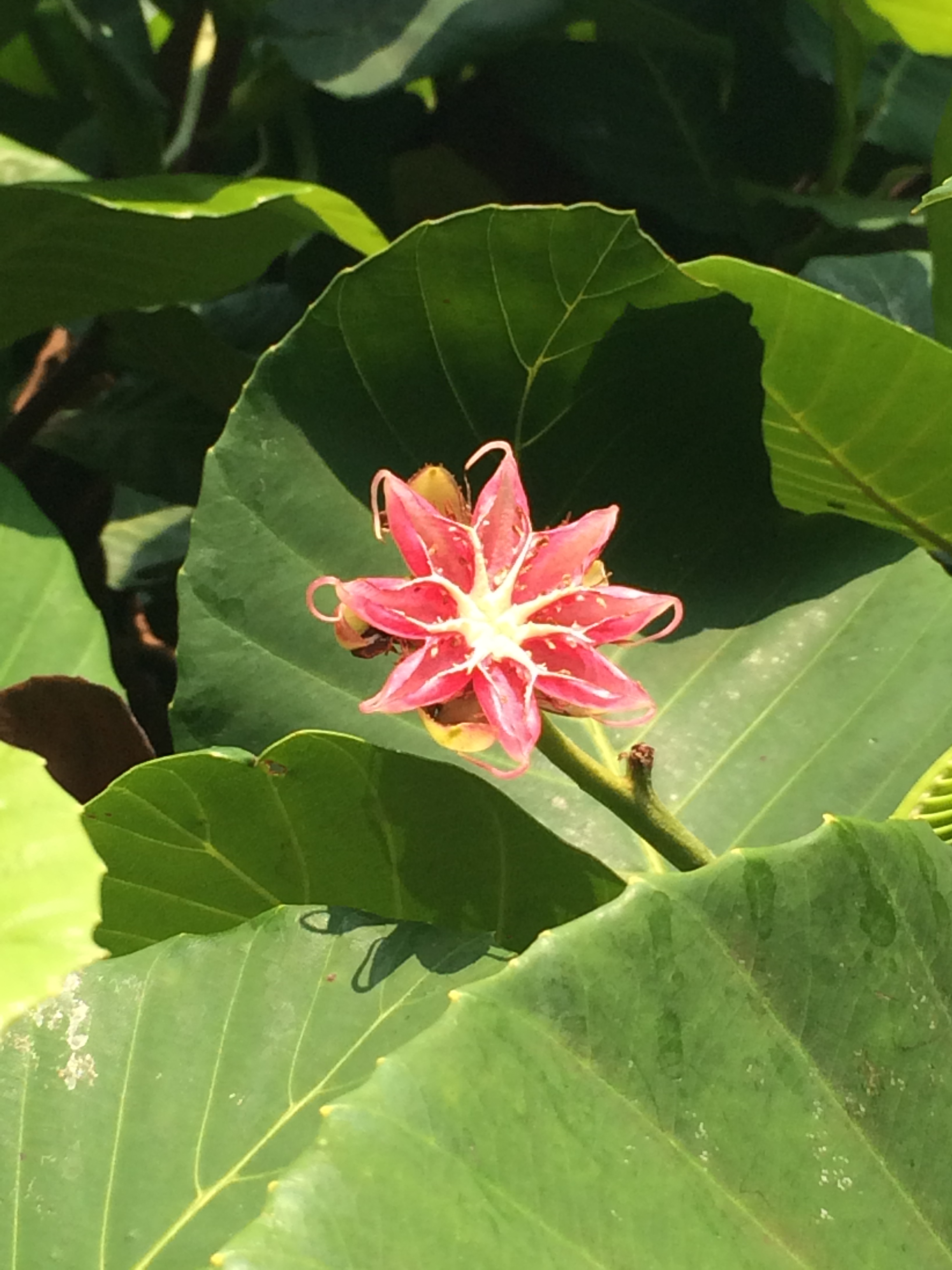 |
| An opened fruit with the bright pinkish star-shaped segments. Photo © Vanessa Lee. |
The unopened fruits are surrounded by thick red sepals. One way to recognize unopened fruits from flower buds is that the fruits face upwards while flower buds face down. [14] Coincidentally, ripe fruit splits open at 3 am too! It splits into pinkish star-shaped segments to reveal seeds covered in red arils. These brightly colored arils always attract birds and sometimes monkeys, which eat the flesh and aid in dispersing the seeds. [12] [14]
4.1.5 Type specimen information
(See 'Glossary to terms')The Dillenia suffruticosa holotype specimen can be found at Royal Botanic Gardens, Kew (barcode K000687374). http://specimens.kew.org/herbarium/K000687374 Reference to this type specimen may aid in to validate the identification of the Simpoh Air.
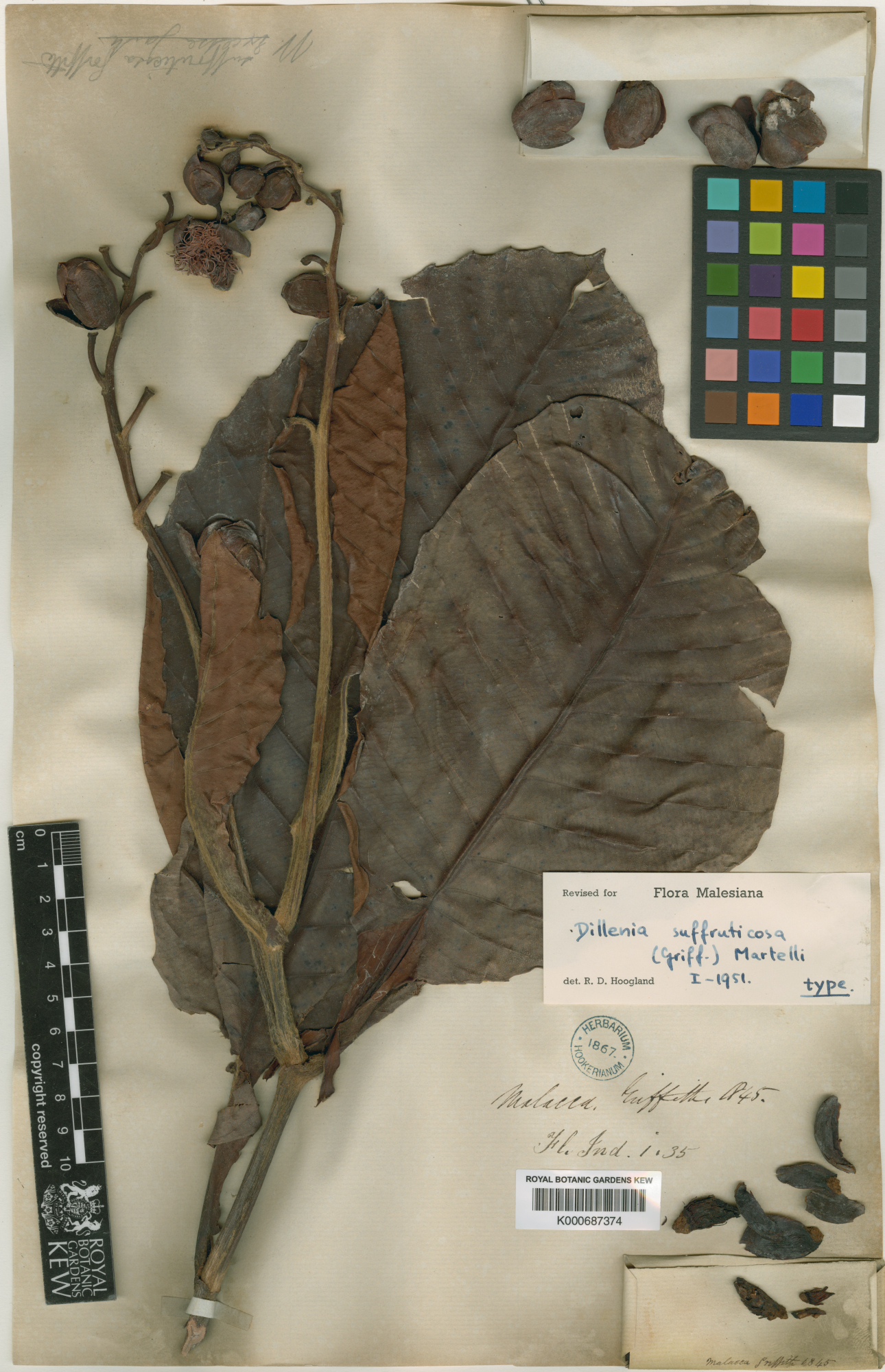 |
| The holotype specimen. © Royal Botanic Gardens, Kew. |
5. Why is this plant important to us?
5.1 Economic Importance
The leaves of the plant were traditionally used to wrap foods, however as plastic got popular, the leaves got replaced and currently only traditional foods like the tempeh, are still wrapped in them. [12] [14]
Recently, a team of researchers have discovered that the Simpoh Air plant exhibits antioxidant and cytotoxic activity, which could lead to a possible cure for cancer. [1]
5. 2 Ecological Importance
Simpoh Air is considered a keystone species in the adinandra belukar, a type of coastal-hill forest distinctive in Singapore and surrounding areas within a 150 km radius. [10] Plants within adinandra belukar are generally associated with white sand soils. [8] [17] Adinandra belukar occurs on exceptionally infertile soils; all the soils in Singapore appear low in nitrogen and phosphorus levels as compared to soils of other dipterocarp forests, the primary forest type of most lowland areas in the region. [17] The low nitrogen and phosphorus levels indicate that the availability of nutrients will be low and considering the highly acidic nature of the soil, may affect the health of the plants thriving. [10] These plants are able to establish themselves readily on sites that were previously degraded by human activities sites due to the frequent and prolific seed production and efficient seed dispersal. [10] Some of the plants that are commonly observed within the same area as this species are as follow:
- Adinandra dumosa (Tiup tiup)
- Fagraea fragrans (Tembusu)
- Ficus grossularioides (White-leaved Fig)
Simpoh Air can be a good indicator of availability of water source since this plant usually has very deep tap roots to reach underground water sources. Thus some people, especially in countries where there is no proper plumbing, use the plant as a guide to decide where to dig a well. [12]
This plant can be found commonly in sandy areas, and also in the secondary growth and in swamps. In sandy areas, Simpoh Air acts as a pioneering species, colonizing where other trees are not able to establish themselves. [10] The low spreading shrub of this species provides shade for seedlings of other tree species to establish themselves. In this manner, other plants are able to successfully establish themselves and diversify the community within the area.
Food and shelter are provided by the Simpoh Air for other plants and creatures. Some creatures that can be found on or near the Simpoh Air:
5.2.1 Yellow-vented Bulbul, Pycnonotus goiavier
Considered as one of the most common bird in Singapore, they are found everywhere except in the deep forest. They used to be found in mangroves and coastal shrubs and are now commonly found in parks, gardens and plantations. These birds can be found foraging among the Simpoh Air plants and may nest among them! They are known to feed on the red-colored seeds within the fruits of this plant and aid in seed dispersal of this plant. [15] Look out for these birds within your neighborhood and also near Simpoh Air plants with the help of these identification tools to help you.
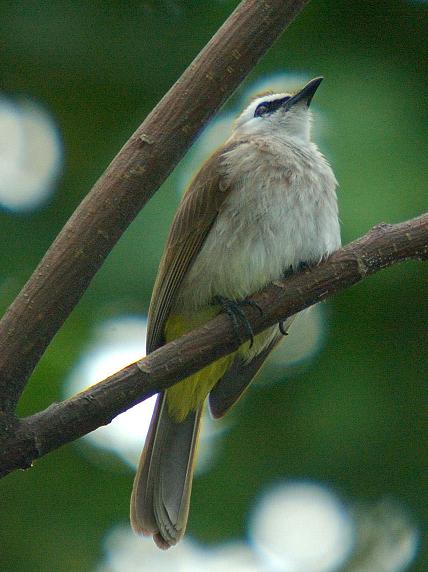 |
| Yellow-vented Bulbul perching on a branch. Photo © singaporebirds.blogspot.sg. |
5.2.2 Pink-necked Green Pigeon, Treron vernans
The red-colored seeds within the ripe fruits of this species are sometimes observed to be feasted upon by these adorable birds! These birds often feed on the seeds very early in the morning and by late morning, the seeds would have been gone. [4] The Pink-necked Green Pigeons are also seed dispersal of Simpoh Air! [13]
This bird is known to be arboreal and seldom come to the ground unless to drink. An interesting fact is that they are the only Green Pigeons found commonly outside of primary forest. They are fond of habitats with trees that provide fruits as well as a safe perch including mangroves, scrub, secondary forest, forest edge. [13]
The male is very colorful and its pinkish neck effectively separates it from other closely related pigeons. [2] The females can easily be confused with other species but fortunately is usually seen feeding with males and is all green except for a yellowish wing stripe seen at rest. [2] If you would like to find out more on this species, follow the links here.
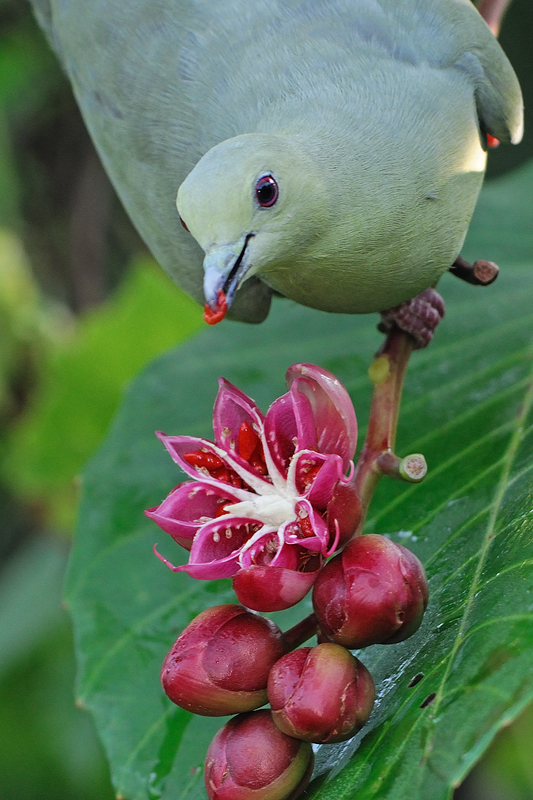 |
| Female Pink-necked Green Pigeon feeding on the brightly colored red seeds from the Simpoh Air fruits. Photo © Mark Chua. |
5.2.3 Carpenter bee, Xylocopa spp.
Carpenter bees are large (2 cm or more), heavy-bodied bees that resemble bumble bees. [3] They are usually distinguished by their hairless abdomens and a shiny black spot on their back. [3] These bees are often seen visiting open flowers, which they pollinate as they feed on the nectar and pollen. [3] They are an important pollinator of Simpoh Air. [12] Be careful should you spot this bee near as they are known to bore into dry wood, such as logs or houses to build their nest! [3] Do not irritate the bees if you encounter them as they may be aggressive; the females possess stings but the males are stingless. [3] If you wish to find out more about carpenter bees, you may wish to visit these links.
Carpenter bee (Xylocopa latipes) visiting some flowers in Singapore. (Video taken from YouTube by Leong Tzi Ming, Meristogenys69)
5.2.4 Shield bug, Pycanum rubens
The shield bug Pycanum rubens (3 cm long) is often spotted on its host plant, none other than the Simpoh Air! These shield bugs are often observed sucking the sap from the leaves of Simpoh Air. [7] For more images and details about these lovely bugs, you may wish to follow the links here.
| Shield bugs spotted mating on the underside of the Simpoh Air leaf. Photo © Vanessa Lee. |
5.2.4 Weaver ants, Oecophylla smaragdina
Weaver ants are also often spotted on this host plant forming nests with the leaves. Being eusocial organisms, they are often observed to be in large groups. Many animals fear them due to the nasty bites they give when an intruder blocks their path or disturbs their nests. If you would like to know more about this species of ant, you may wish to visit here.
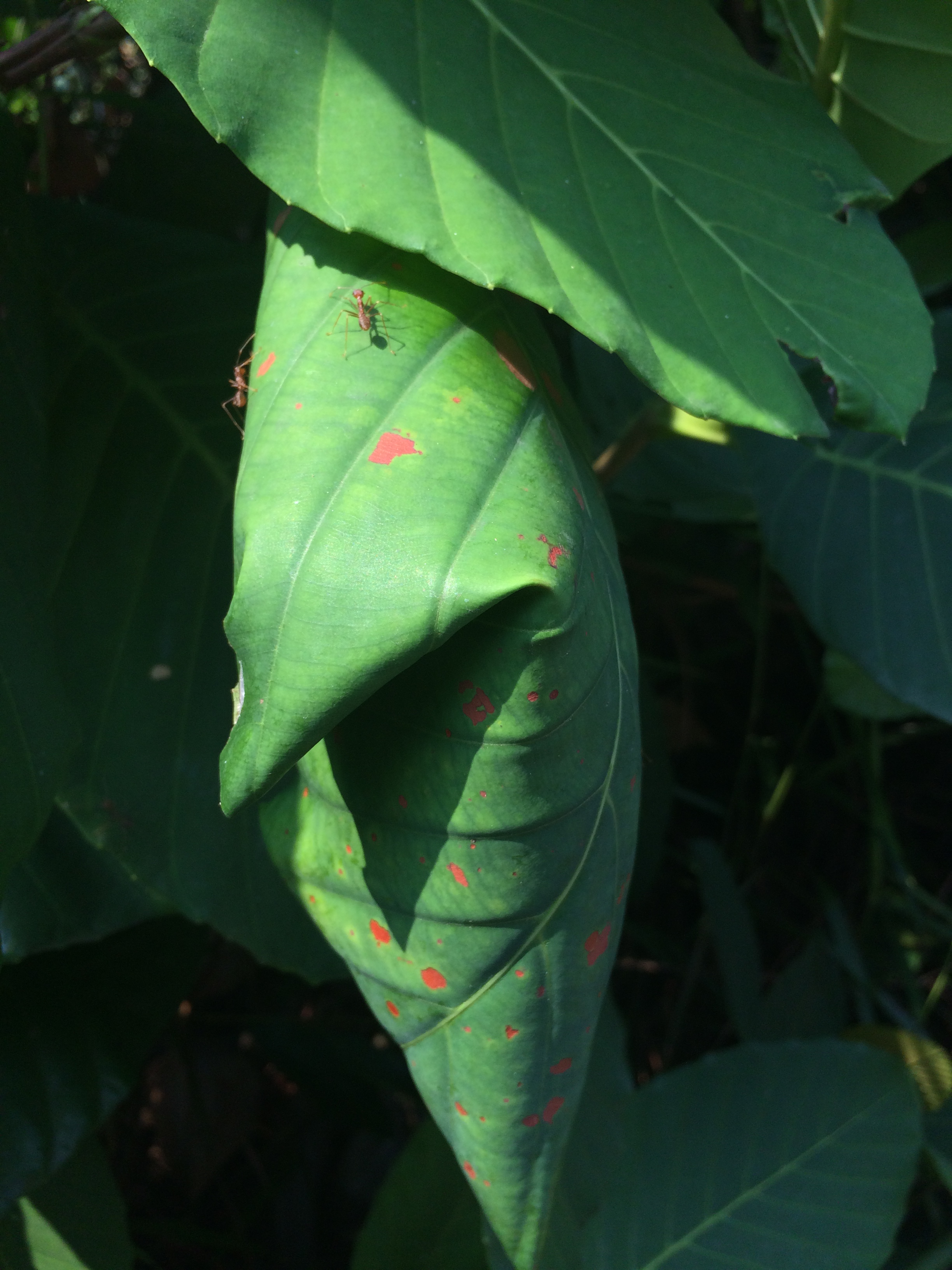 |
| A typical weaver ants' nest constructed from glueing the leaves together using silk secreted by their larvae. Photo © Vanessa Lee. |
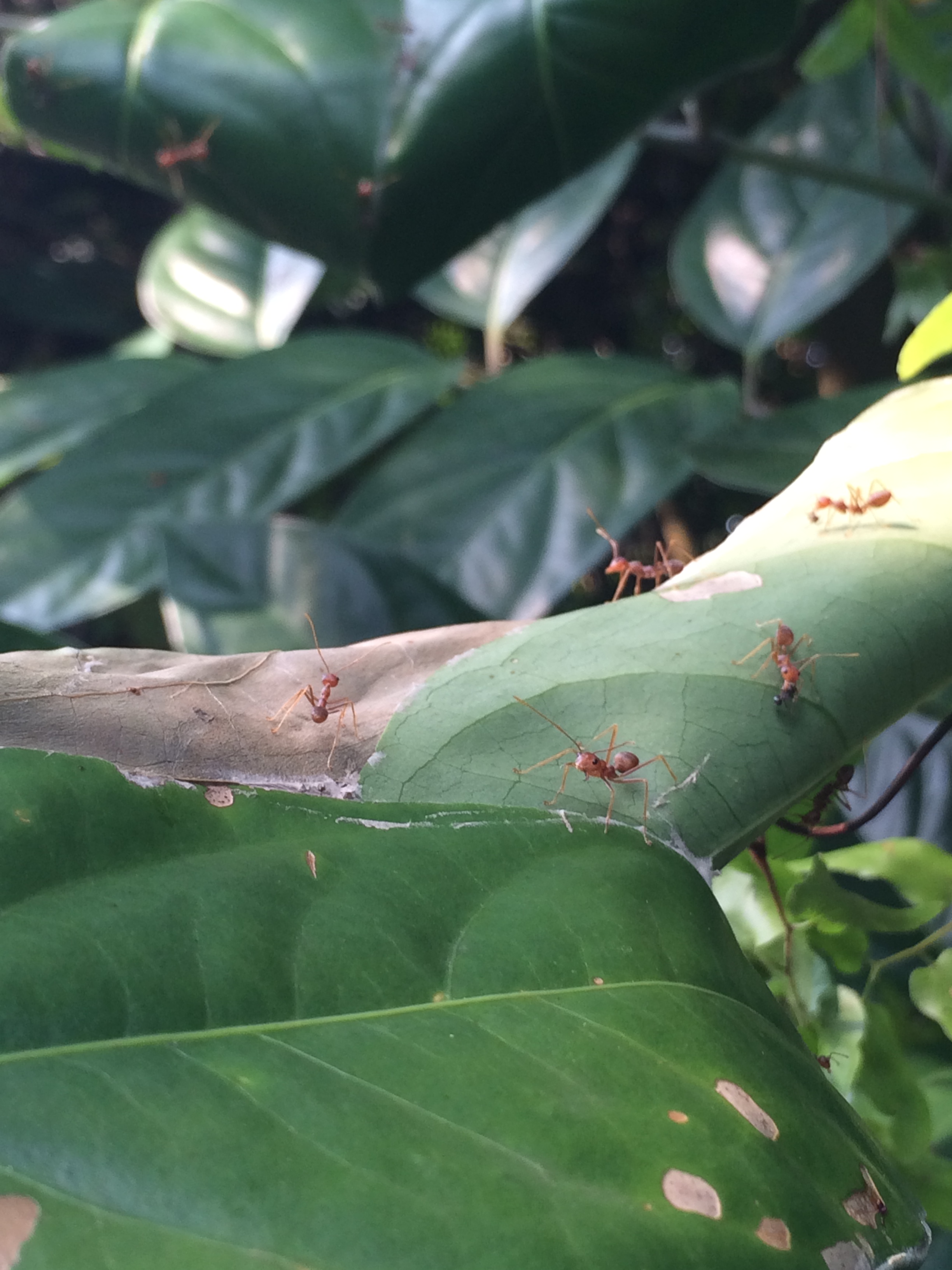 |
| Weaver ants guarding their nest. These ants are fierce and give a nasty bite. Photo © Vanessa Lee. |
Weaver ants working cohesively in nature. (Video taken from YouTube by BacktoNature, from BacktoNature)
5.2.5 Ant-mimicking jumping spiders, Myrmarachne spp.
Ant-mimickingjumping spiders can sometimes be found on this plant too! Just look carefully at the leaves and you may notice them near the ants. These spiders sometimes weave their nest on the leaves or underside of the leaves of Simpoh Air. Some of the species that you may encounter when you see Simpoh Air include Myrmarachne plataleoides and Myrmarachne cornuta.
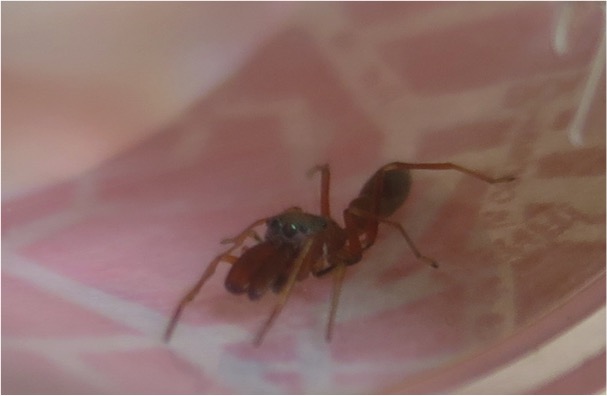 |
| Male ant-mimicking jumping spider that was found on a Simpoh Air plant along Kent Ridge Road. Photo © Vanessa Lee. |
Myrmarachne plataleoides (in the above picture) are usually found near colonies of the weaver ants and are well-known for their mimicry ability. One way to differentiate them from the feisty ants is that when approached, this spider may start to jump or scurry to the underside of the leaf to hide. They are usually not observed to have any interaction with the weaver ants. If you would like to know more about this species of spider, hop on here! More photos and details on this organism can be found following these links.
5.2.6 Common Tailorbird, Orthotomus sutorius
Tailorbirds like to make their nests out of the large leaves of the Simpoh Air. These birds can be identified by their melodious calls which is rather loud at times. They are very common resident throughout the island and islands on the Northern and Southern side of Singapore.
Common Tailorbird in Singapore chirping at a balcony of a house. (Video taken from Youtube by EcoWALKthetalk and with permission from EcoWALKthetalk)
At times when these nests fall to the ground, the large leaves also hold shallow pools of rainwater in which, encourage breeding of mosquitoes. Thus, areas with Simpoh Air are often mosquito-infested. [11] To find out more about this beautiful creature, follow these links!
6. Glossary of terms
| Pioneer species |
Hardy species that are the first to colonize previously disrupted or damaged ecosystems. Presence of these species usually leads to a chain of ecological succession that results in more organisms appearing in the ecosystem. |
| Secondary succession |
An ecological succession of plant and animal communities in a previously disturbed area. |
| Arils |
Extra seed coverings, usually colored and hairy or fleshy. |
| Sepals |
Parts of the plant that encloses the petals; usually green and leaf-like. |
| Type specimen |
The specimen, or each of a set of specimens, on which the description and name of a new species is based. |
| Holotype |
A single type specimen upon which the description and name of a new species is based. |
| Antioxidant |
A substance that inhibits oxidation, especially one that is used to prevent the spoiling of stored food products. |
| Cytotoxic |
Toxic to cells. |
| Arboreal |
Inhabiting in trees. |
| Scrub |
An area of land covered with short trees and bushes, growing on dry land of low quality. |
| Adinandra belukar |
A type of vegetation that is distinctive in Singapore, which is dominated by Adinandra dumosa (Tiup tiup), a plant commonly found within this vegetation. 'Belukar' stands for secondary forest in Malay. |
7. Links
More on shield bug, Pycanum ruben:
More on Ant-mimicking jumping spider, Myrmarachne spp.:
- Detailed description of Ant-mimicking jumping spiders in Singapore
- Photos of //Myrmarachne// spp. worldwide
More on Common Tailorbird, Orthotomus sutorius:
- Mangrove wetland wildlife at Sungei Buloh Nature Park
- Common Tailorbird - Oiseaux-Birds
- Distribution map of Common Tailorbird and Recordings of this species' calls
More on Yellow-vented Bulbul, Pycnonotus goiavier:
- Detailed description of Yellow-vented Bulbul
- Distribution map of Yellow-vented Bulbul and Recordings of this species' calls
More on Pink-necked Green Pigeon, Treron vernans:
- Interesting facts on Pink-necked Green Pigeon
- More photos of Pink-necked Green Pigeon
- Distribution map of Pink-necked Green Pigeon and Recordings of this species' calls
More on Carpenter Bees (Xylocopa spp.), their habitat and distribution:
- Photos of Carpenter Bees (Xylocopa spp.)
- Short description of Carpenter Bees
- Detailed description of //Xylocopa aestuans//
Find out more on buzz pollination from the following links:
Other online pages on the Simpoh Air can be found at the following links:
http://blackdillenia.wordpress.com/2010/01/23/hey-you-simpoh-air/
http://www.wildsingapore.com/wildfacts/plants/others/dillenia/suffruticosa.htm
https://florafaunaweb.nparks.gov.sg/Special-Pages/plant-detail.aspx?id=2847
8. References
- Armania, N., Yazan, L.S., Musa, S.N., Ismail, I.S., Foo, J.B., Chan, K.W., Noreen, H., Hisyam, A.H., Zulfahmi, S., and Ismail, M. (2013). Dillenia suffruticosa exhibited antioxidant and cytotoxic activity through induction of apoptosis and G2/M cell cycle arrest. Journal of Ethnopharmacology 146, 525-535.
- Briffett, C. (1992). A Guide to the Common Birds of Singapore. Singapore: Singapore Science Centre.
- Chou, L.M., Tan, H.T.W., and Yeo, D.C.J. (2006). The Natural Heritage of Singapore. Singapore: Pearson Prentice Hall.
- Chua, M. (2009). Birds and Dillenia suffruticosa [Online]. Singapore: Bird Ecology Study Group. Available: http://www.besgroup.org/2009/01/26/birds-and-dillenia-suffruticosa/ [Accessed 11 November 2014].
- November (2005). "Kampong Cooking on Ubin", (ed.) Kerabuinleaf. (Pulau Ubin Stories: Blogger).
- NParks (2013). Dillenia suffruticosa (Griff. ex Hook.f. & Thomson) Martelli [Online]. Singapore. Available: https://florafaunaweb.nparks.gov.sg/Special-Pages/plant-detail.aspx?id=2847 [Accessed 19 October 2014].
- Quek, A. 2014). Insect of the Month, January 2014 - Shield Bugs. Bugs & Insects of Singapore [Online]. Available from: http://bugsandinsects.wordpress.com/tag/stink-bug/ 2014].
- Richards, P.W. (1952). Tropical rain forest – an ecological study. Cambridge: Cambridge University Press.
- RMBR (2014). Dillenia suffruticosa [Online]. Raffles Musuem of Biodiversity Research. Available: http://137.132.71.21/dna/organisms/details/362 [Accessed 19 October 2014].
- Sim, J.W.S., Tan, H.T.W., and Turner, I.M. (1992). Adinandra belukar: an anthropogenic heath forest in Singapore. Vegetatio 102, 125-137.
- Strange, M., and Jeyarajasingam, A. (2003). Birds: A Photographic Guide to the Birds of Peninsular Malaysia and Singapore. Singapore: Sun tree Publishing.
- Tan, H.T.W., Morgany, T., and Tan, K.-X. (2003). "The History and Biology of Kent Ridge Park". National Univeristy of Singapore).
- Tan, R. (2001a). Pink-necked Green Pigeon [Online]. Mangrove and wetland wildlife at Sungei Buloh Nature Park. Available: http://www.naturia.per.sg/buloh/birds/Treron_vernans.htm [Accessed 11 November 2014].
- Tan, R. (2001b). Simpoh Air (Dillenia suffruticosa) [Online]. Mangrove and wetland wildlife at Sungei Buloh Nature Park. Available: http://www.naturia.per.sg/buloh/plants/simpoh_air.htm [Accessed 19 October 2014].
- Tan, R. (2001c). Yellow-vented Bulbul Pycnonotus goiavier [Online]. Singapore. Available: http://www.naturia.per.sg/buloh/birds/Pycnonotus_goiavier.htm [Accessed 7 November 2014].
- Vaughan, V. 2010. Is Singapore the worst environmental offender? AsiaOne [Online]. Available: http://news.asiaone.com/News/AsiaOne+News/Singapore/Story/A1Story20100514-216266.html [Accessed 7 November 2014].
- Whitmore, T.C. (1984). Tropical rain forests of the Far East. Oxford: Oxford University Press.
- Yeo, R. (2012). Coastal Shrubs & Trees with Simple Leaves in Singapore [Online]. Available: http://tidechaser.blogspot.sg/2012/07/coastal-shrubs-trees-simple-leaves.html - D [Accessed 19 October 2014].